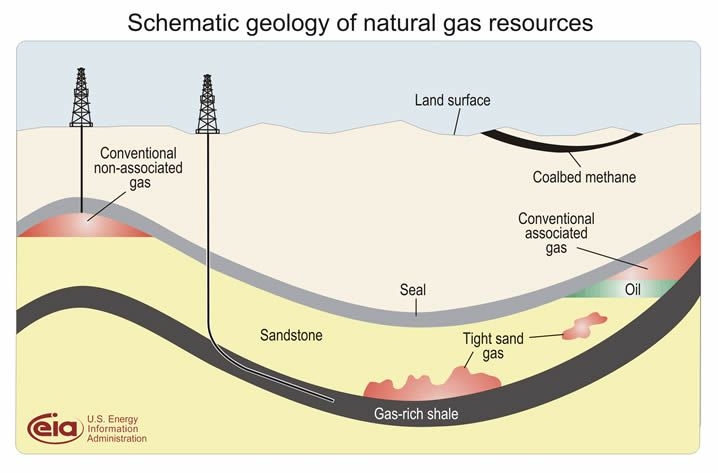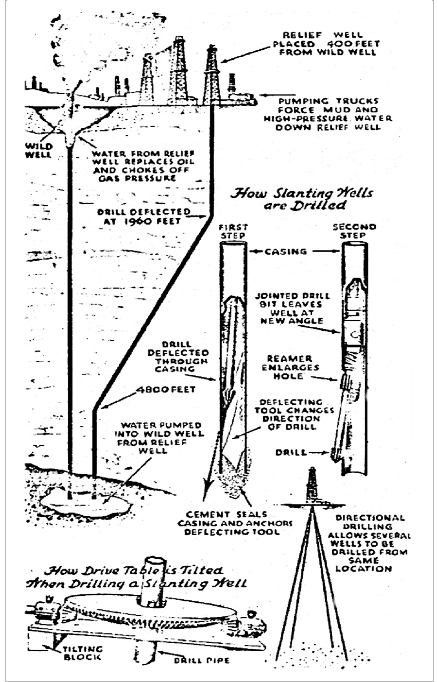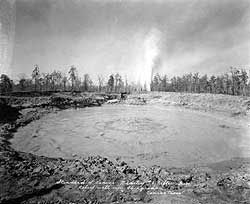Plentiful Gas
My Great Uncle John was adamant that there was a plentiful supply of gas locked up in the shale layers over a mile below the earth's surface. That summer evening around the campfire in 1985, John described how natural gas was bottled up and bonded to the surfaces of the shale rock.
 I was drinking from a bottle of beer. In the middle of his explanation, John reached out and grabbed the bottle out of my hand. He stuck his thumb over the top and shook the bottle little bit, and then pulled his thumb away. Beer foamed out of the neck. John said that methane (the core component of natural gas) and other gases were bound to the stone because of the immense pressure a mile beneath the surface. He said it wasn't enough just to punch a hole into the shale layer; somehow the shale had to be cracked and broken up to release the gas.
I was drinking from a bottle of beer. In the middle of his explanation, John reached out and grabbed the bottle out of my hand. He stuck his thumb over the top and shook the bottle little bit, and then pulled his thumb away. Beer foamed out of the neck. John said that methane (the core component of natural gas) and other gases were bound to the stone because of the immense pressure a mile beneath the surface. He said it wasn't enough just to punch a hole into the shale layer; somehow the shale had to be cracked and broken up to release the gas.
John explained that it didn't take very many wells to exploit a conventional natural gas reserve. Conventional reserves are actually layers of porous rock, like sandstone, that lie beneath an impenetrable layer of a dense rock, such as granite or another igneous stone. That impenetrable layer helps trap the gas inside the sandstone. In a geological timeline, the sandstone layers, which trap decaying animals and plant life, form before the layer of impenetrable rock above. More layers of stone and rock build up, creating incredible pressure and heat. Under the pressure and heat, gas and oil form. John said this same process created the layers of coal and the layers of gas-rich shale.
John said that it was easy to exploit conventional gas because it didn't take very many wells to get to the reserve. The gas, lighter than air, naturally rose through the sandstone until it was trapped by the capping seal layer. Theoretically, Uncle John said, if you could aim your well to puncture the seal at its highest point, a single well could extract all the gas out of a field. John said you couldn't do that with shale because the gas was trapped in the rock itself. Shale is very dense, and the gas doesn't rise through the shale. John talked about ways to dig up the shale and crush it to capture the gas, but that required digging very deep mines, which was far too expensive. I don't remember if John suspected that there was oil in shale. Clearly, based on what we see in the Bakken oil play, there definitely is oil trapped in the layers of shale rock.
Drilling “Whip-stocked” Wells
Horizontal drilling is not all new. The technical term is directional drilling or slant drilling.
Have you ever wondered how utilities can run the fiber-optic cable underneath the roadway without tearing up the pavement? That's a form of horizontal directional drilling. Directional boring allows for the durable trenchless installation of underground pipes, conduits, and cables.
What happened to the oilfields today is a combination of vertical drilling that flares into a surface in seam (SIS). Mostly the wells are simple vertical bores that curve into a horizontal path and follow a shale or coal seam. Some of the well systems get a little fancier, and through the application of gyroscopes and computerization, the horizontal bores are aimed to intersect with other vertical and non-vertical wellbores.
The oil industry started to understand that wells were not always vertical in the late 1920s when a series of lawsuits against the Sun Oil Company occurred. The lawsuits charged Sun with driving wells into adjoining properties owned by other people. While it is easy to measure the inclination of a wellbore (its deviation from a vertical axis), measuring the direction is far more difficult. The Sperry Corporation modified small gyroscopic compasses while under contract with Sun Oil to create equipment that could measure any given point in a wellbore.
 This is when the pioneers in directional drilling, John Eastman, and George Failing, helped save Humble Oil's Conroe, Texas oilfield in 1934. Discovered in 1931, the 19,000 acre Conroe field — the third largest in the US at the time — was a prolific but unstable oilfield. Charged under the high pressure of natural gas, the Conroe field created gushers for the wildcat oilman who worked the field. By the end of 1932, over 60 oil wells produced over 65,000 barrels of oil a day. But disaster struck in January 1933, when the Madeley #1 well blew in as a gusher and directly burst into flame. Attempts to put the fire out with dynamite blasts and tons of dirt failed, and as the oil and gas burned off, the wells started to collapse into a crater filled with burning crude. Soon, two other wells started to feed the flames, and the entire field was in danger. People in Houston, 35 miles away, saw the thick columns of black smoke.
This is when the pioneers in directional drilling, John Eastman, and George Failing, helped save Humble Oil's Conroe, Texas oilfield in 1934. Discovered in 1931, the 19,000 acre Conroe field — the third largest in the US at the time — was a prolific but unstable oilfield. Charged under the high pressure of natural gas, the Conroe field created gushers for the wildcat oilman who worked the field. By the end of 1932, over 60 oil wells produced over 65,000 barrels of oil a day. But disaster struck in January 1933, when the Madeley #1 well blew in as a gusher and directly burst into flame. Attempts to put the fire out with dynamite blasts and tons of dirt failed, and as the oil and gas burned off, the wells started to collapse into a crater filled with burning crude. Soon, two other wells started to feed the flames, and the entire field was in danger. People in Houston, 35 miles away, saw the thick columns of black smoke.
George Failing, an Enid, Oklahoma entrepreneur, had a crew working near Conroe when the fire broke out. Failing's crew was using a newly patented portable drilling truck that proved to revolutionize drilling. A traditional steam-powered rotary rig took about a week to set up and drill a 50-foot borehole. Failing's truck could drill 10- to 50-foot deep holes in a single day. With this capacity, Failing and his crew quickly drilled multiple relief wells, releasing enormous gas pressure that pushed the oil up through the flaming, destroyed well. Relieving the pressure enabled the fire crews to put out the fire.
With the fire out, there remained another problem. The tremendous gas pressure of the Conroe field continued to pump oil out of the destroyed well. Using bulldozers, the oil companies created a lake of oil that they could then capture and pump off. They still needed to cap the flow of oil, however, or the field would run out of head pressure, destroying its productivity.
 This is where John Eastman came in. Humble Oil hired Eastman's wells survey company to drill a relief well that would intersect the damaged well from over 400 feet away. Using tapered wedges in a borehole that forced the drill bit sideways in a new direction, Eastman whip-stocked the relief well, digging deeper and deeper over a three-month period, correcting and re-aiming the relief well until it reached its target over 5,000 feet deep.
This is where John Eastman came in. Humble Oil hired Eastman's wells survey company to drill a relief well that would intersect the damaged well from over 400 feet away. Using tapered wedges in a borehole that forced the drill bit sideways in a new direction, Eastman whip-stocked the relief well, digging deeper and deeper over a three-month period, correcting and re-aiming the relief well until it reached its target over 5,000 feet deep.
Today’s Application of Drilling and Production
Chesapeake Energy is one of the major players in the development of shale gas fields. We include a video of the drilling process to help illustrate the modern process of developing directional wells.
Chesapeake is huge in the Barnett Shale play of Texas and Oklahoma. If you fly through DFW airport, look out the window to see if you can see some of the drilling rigs working that area around the airport. This video again illustrates how Chesapeake is working the Barnett play.
Marathon Oil is not only after gas, they are using the same drilling and fracking technology to go after US oil reserves.
This Chesapeake video highlights more details of the fracking process.
Fracking is not uncontroversial. A substantial NIMBY and environmental activist movement is pressing for more federal regulation. Today, energy companies must comply with state regulations. Some states, like New York, have banned fracking outright. There is a loud activist movement in Australia too.
Most of the videos you can find are either for or against the practice, so it is hard to find an even-handed view in the media. This video from Hank the Science Guy is a little on the snarky side, but it highlights the concerns of both sides of the argument. True enough, not all is cupcakes and butterflies.


